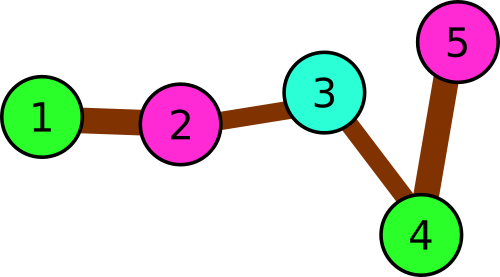Codeforces Round #403 (Div. 2, based on Technocup 2017 Finals) C (dfs+vector)
来源:互联网 发布:廖雪峰python教程博客 编辑:程序博客网 时间:2024/06/05 05:31
Andryusha goes through a park each day. The squares and paths between them look boring to Andryusha, so he decided to decorate them.
The park consists of n squares connected with(n - 1) bidirectional paths in such a way that any square is reachable from any other using these paths. Andryusha decided to hang a colored balloon at each of the squares. The baloons' colors are described by positive integers, starting from1. In order to make the park varicolored, Andryusha wants to choose the colors in a special way. More precisely, he wants to use such colors that ifa,b andc are distinct squares thata and b have a direct path between them, andb andc have a direct path between them, then balloon colors on these three squares are distinct.
Andryusha wants to use as little different colors as possible. Help him to choose the colors!
The first line contains single integer n (3 ≤ n ≤ 2·105) — the number of squares in the park.
Each of the next (n - 1) lines contains two integersx andy (1 ≤ x, y ≤ n) — the indices of two squares directly connected by a path.
It is guaranteed that any square is reachable from any other using the paths.
In the first line print single integer k — the minimum number of colors Andryusha has to use.
In the second line print n integers, thei-th of them should be equal to the balloon color on thei-th square. Each of these numbers should be within range from1 to k.
32 31 3
31 3 2
52 35 34 31 3
51 3 2 5 4
52 13 24 35 4
31 2 3 1 2
In the first sample the park consists of three squares: 1 → 3 → 2. Thus, the balloon colors have to be distinct.
 Illustration for the first sample.
Illustration for the first sample. In the second example there are following triples of consequently connected squares:
- 1 → 3 → 2
- 1 → 3 → 4
- 1 → 3 → 5
- 2 → 3 → 4
- 2 → 3 → 5
- 4 → 3 → 5
 Illustration for the second sample.
Illustration for the second sample. In the third example there are following triples:
- 1 → 2 → 3
- 2 → 3 → 4
- 3 → 4 → 5
 Illustration for the third sample.
Illustration for the third sample.
#include<bits/stdc++.h> using namespace std; #define lp(i,n) for(int i=0;i<n;i++) #define mp make_pair #define N 100009 #define MOD 1000000007 #define F first #define S second #define wt(x) cout << # x <<" = " << x << endl #define FASTIO ios::sync_with_stdio(0),cin.tie(0),cout.tie(0) #define K 1005 typedef long long ll; typedef pair<int, int> pi; int n; vector<int> v[200005]; int c[200005]; int maxc=1; void dfs(int node,int p) { int cur=1;// printf("%d\n",v[node].size()); for(int i=0; i<v[node].size(); i++) { int child=v[node][i];// printf("child=%d\n",child); if(child==p)continue; while(cur==c[p] || cur==c[node])cur++; maxc=max(maxc,cur); c[child]=cur++; dfs(child,node); } } int main() { // freopen("input.txt", "r", stdin); // freopen("output.txt", "w", stdout); cin>>n; for(int i=0; i<n-1; i++) { int x,y; cin>>x>>y; v[x].push_back(y); v[y].push_back(x); } c[1]=1; dfs(1,-1); cout<<maxc<<endl; for(int i=1; i<=n; i++) cout<<c[i]<<" "; return 0; }- Codeforces Round #403 (Div. 2, based on Technocup 2017 Finals) C (dfs+vector)
- Codeforces Round #403 (Div. 2, based on Technocup 2017 Finals)
- Codeforces Round #403 (Div. 2, based on Technocup 2017 Finals
- Codeforces Round #403 (Div. 2, based on Technocup 2017 Finals)
- Codeforces Round #403 (Div. 2, based on Technocup 2017 Finals) 题解(ABCDE) (二分,dfs序,数据结构)
- Codeforces Round #403 (Div. 2, based on Technocup 2017 Finals)【A,B,C】
- Codeforces Round #403 (Div. 2, based on Technocup 2017 Finals)A,B,C
- Codeforces Round #403 (Div. 2, based on Technocup 2017 Finals) A.B.C
- Codeforces Round #403 (Div. 2, based on Technocup 2017 Finals) C
- Codeforces Round #403 (Div. 2, based on Technocup 2017 Finals) B.(三分)
- Codeforces Round #403 (Div. 2, based on Technocup 2017 Finals) B.(三分)
- [Updating]Codeforces Round #403 (Div. 2, based on Technocup 2017 Finals)解题报告
- 【解题报告】Codeforces Round #403 (Div. 2, based on Technocup 2017 Finals)
- Codeforces Round #403 (Div. 2, based on Technocup 2017 Finals) A
- Codeforces Round #403 (Div. 1, based on Technocup 2017 Finals) A. Andryusha and Colored Balloons
- Codeforces Round #403 (Div. 2, based on Technocup 2017 Finals) B. The Meeting Place Cannot Be Change
- Codeforces Round #403 (Div. 2, based on Technocup 2017 Finals) B. The Meeting Place Cannot Be Change
- Codeforces Round #380 (Div. 2, Rated, Based on Technocup 2017
- SPOJ BLMIRINA 计算几何
- 排序--2.希尔
- 10、虚拟机安装centos 及安装java
- Node的简单读取文件内容
- 0306 HTML&CSS
- Codeforces Round #403 (Div. 2, based on Technocup 2017 Finals) C (dfs+vector)
- 3.6
- 反射的原理
- [ windows程序设计(programing windows) ]
- MPAndroidChart API详解
- python全站爬虫知识点详解
- Java修饰符汇总
- 判断一个点是否在多边形区域内
- 堆和栈


